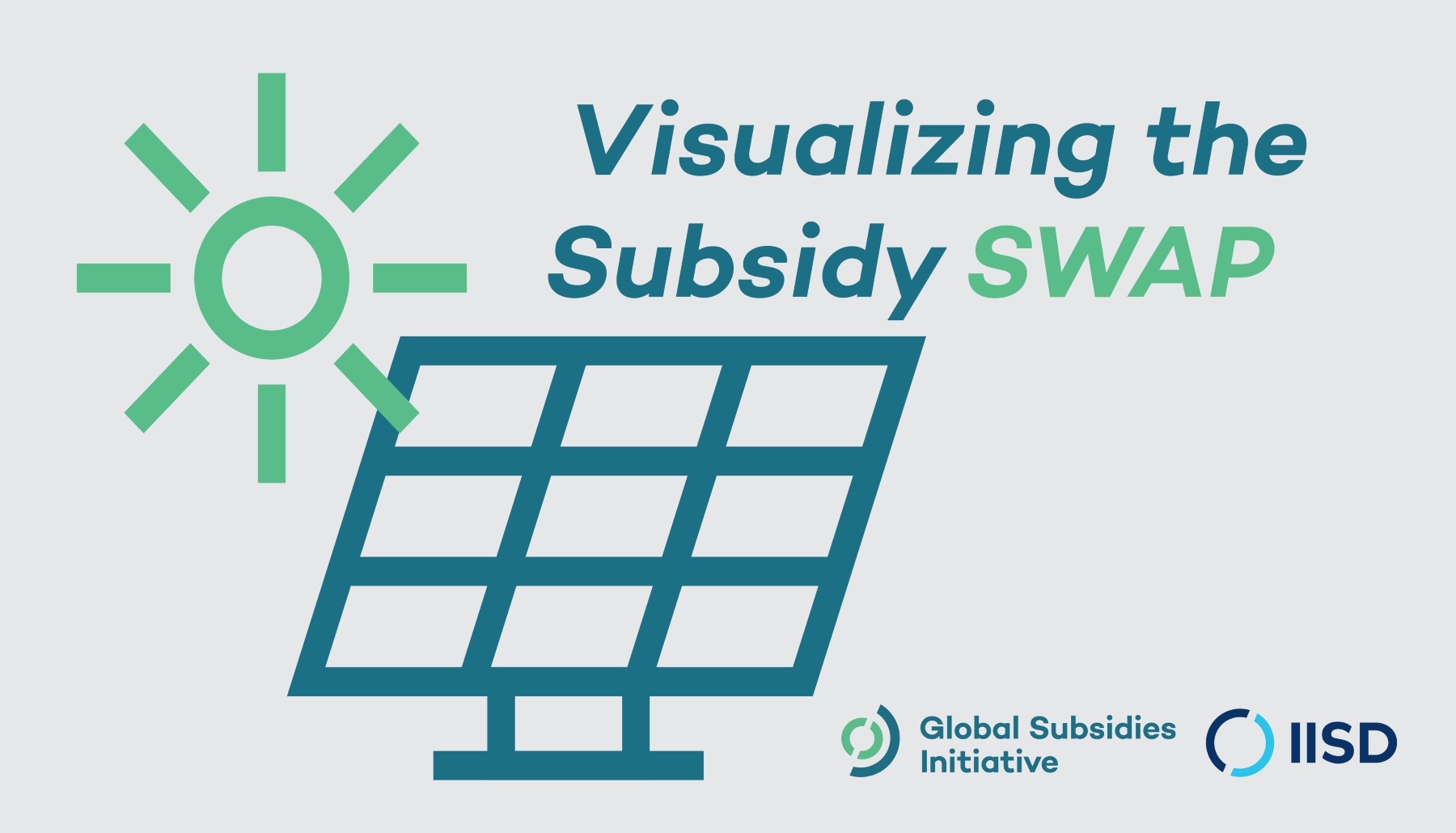Description
Fossil fuel subsidies are a cost that governments can no longer afford to ignore from both economic and social perspectives. Global subsidies to both consumers and producers of fossil fuels were reported at USD 425 billion in 2015. Research estimates suggest that removing all fossil fuel subsidies would decrease global carbon emissions anywhere between 6.4–8.2 percent by 2050. By reinvesting these savings into renewable energy, energy efficiency, education, healthcare, and targeted social protection schemes for adaptation to climate change, countries have major opportunities to support the delivery of the both the Paris Agreement and the Sustainable Development Goals. This concept is what we call the subsidy SWAP.
IISD’s Global Subsidies Initiative works with governments and partners to help remove fossil fuel subsidies that work against sustainable development. Beyond traditional forms of reporting our research, we’ve begun engaging in more visual approaches to help better communicate opportunities for SWAPs to regional audiences thanks to the support from the Nordic Council of Ministers and the Government of Denmark. This includes producing an animated video that introduces the concept subsidy SWAP in a simplified manner, along with several infographics that illustrate where savings could be reallocated in Canada, India, and Indonesia. We currently have the research outlining further SWAP opportunities in several countries, and through this project, we are keen on continuing using innovative visual mediums to help communicate the human connection between swapping subsidies for socially beneficial initiatives.
Useful links about "Visualizing the Subsidy SWAP":
http://www.iisd.org//faq/unpacking-canadas-fossil-fuel-subsidies/
http://www.iisd.org/gsi/videos/introducing-subsidy-swap
http://www.iisd.org/gsi/faqs/indonesia
http://www.iisd.org/gsi/faqs/india
http://www.iisd.org/gsi/subsidy-watch-blog/how-can-clean-energy-transition-be-funded-swap-subsidies-fossil-fuels-clean
http://www.iisd.org/gsi/subsidy-watch-blog/how-can-zambia-meet-rising-energy-demand-are-subsidy-swaps-answer
http://www.iisd.org/gsi/videos/scaling-green-energy-finance-swapping-fossil-fuel-subsidies-sustainable-energy-solutions
http://www.iisd.org/library/making-switch-fossil-fuel-subsidies-sustainable-energy
http://www.iisd.org/gsi/news-events/transferring-fossil-fuel-subsidies-clean-energy-could-yield-major-savings-dollars-and-ghg
Objectives and beneficiaries
Increase awareness about subsidy SWAPs: Introduce arguments in favour of fossil fuel subsidy reform within the energy access community and among engaged citizens
Inspire behavioral change: channel recommendations (supported by clear visual messaging on subsidy SWAPs) into implementable policy goals for governments
Raise the profile of IISD’s Global Subsidies Initiative: Showcase IISD-GSI’s research to position IISD-GSI for further research opportunities and policy work on targeting energy subsidies for access, all the while positioning IISD-GSI as a go-to resource for visual data on fossil fuel subsidies
Strong points of the solution
By drawing on everyday examples of where public funds could be better allocated in a visually compelling way, we are able to build a stronger case to convince both policymakers and citizens of the benefits that come with subsidy SWAPs. We created a Canada-focused FAQ-style landing page containing simplified questions and answers on the topic, which also embeds several infographics. One visual outlines how CAD $3.3 billion – the number of subsidies allocated to oil and gas producers by the federal government – could educate 260,000 students; provide a hospital bed for 16,000,000 days; provide job training for 330,000 workers; or put an extra 94$ in a Canadian’s pocket. This page consistently ranks among our top 20 visited pages, and visitors are spending close to six minutes going through the content. Furthermore, when searching for fossil fuel subsidies in Canada on Google, our landing page comes up among the first results, and it even includes a rich snippet of our infographic.
Expected results and benefits for climate change adaptation and mitigation
Fossil fuel subsidies are a cost that governments can no longer afford to ignore from both economic and social perspectives. Global subsidies to both consumers and producers of fossil fuels were reported at USD 425 billion in 2015. Research estimates suggest that removing all fossil fuel subsidies would decrease global carbon emissions anywhere between 6.4–8.2 per cent by 2050. Fossil fuel subsidies not only work against their initial objective, they work directly against sustainable development.
By working alongside governments and providing them with visually compelling outlines of subsidy SWAP opportunities, we are helping them move away from environmentally harmful sources of energy and accelerating the ongoing energy transition, which will ultimately help contain global temperatures from rising and provide governments with stronger incentives to meet its Paris climate targets.
Scalability potential of the solution
There is clearly an appetite for accessible content based on credible research that can resonate with broader audiences to deliver the impact that it deserves, and we would like to continue helping people visualize what a subsidy SWAP could entail in innovative ways.
Subsidy SWAP opportunities can be visualized for multiple levels of governance – country, provincial/state, regional or municipal. Our aim is to continue expanding on our existing work over the next two years and showcasing more country examples of subsidy SWAP opportunities to ultimately have a full suite of visual aids available to anyone who wishes to make a stronger case for fossil fuel subsidy reform.
[Editor's Note: All information published as submitted by the author(s). Minor edits may have been made for length and clarity.]






